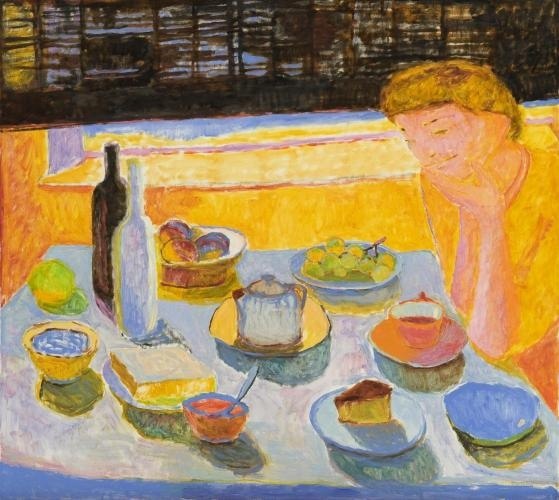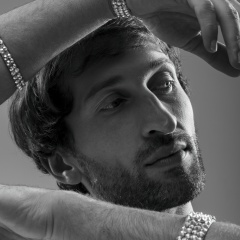Роман русских художников с французской живописью длительностью уже насчитывает более века. Признаний в любви предостаточно. От первых импрессионистских опытов Валентина Серова и Константина Коровина в конце XIX века, до эпохи русского авангарда, выросшего на подпитке коллекциями Щукина и Морозова. Даже в подчеркнуто антимодернистскую эпоху 1930-50-х тоска по цвету и легкости манеры проявлялась в виде скрытых ссылок и публицистической любви-ненависти (вспомним, что у президента Академии Художеств А. Герасимова была коллекция французов)
Легкость в русском искусстве - явление редкое. Оно чаще всего ассоциируется с пустотой и ветреностью (недаром передвижник В. Маковский называл картины Серова 'сифилисом' в искусстве). Тем сильнее стремление русских художников владеть богатством спонтанности, свойственной французской живописи. Для Ирины Данилевской, представляющей новое поколение очарованных 'Парижской школой', стилистической точкой отталкивания стал Пьер Боннар, художник группы 'Наби'.
Когда-то 'Наби' считались завзятыми декадентами. Это неудивительно: они дружили с венцами из легендарного 'Сецессиона' (Густав Климт, Эгон Шиле и другие), писали райские сценки, 'подпорченные' фиолетовыми оттенками холода и распада. Но теперь их язык, на котором свободно разговаривает Данилевская, кажется жизнерадостным и простым. Видимо, запасы декаданса ХХ век исчерпал полностью, раз стиль, являющийся его воплощением, исчерпал энергию потусторонности.
Ирина Данилевская родилась в Москве в 1980 году. В 16 лет она несколько месяцев посещала курсы дизайна в Сорбонне (Париж), а в 17 - уже продавала акварели в маленькой немецкой галерее. Период серьезного ученичества наступил позже: сначала МАХУ, потом - уроки у художника Ильи Правдина. В ее преданности живописи нет позы адепта, в которую так часто встают защитники 'чистого искусства' и французского идеала. Ей просто не интересно иначе. Сюжеты и композиции современны: Данилевская, как и многие модные ныне живописцы обоймы коллекционера Саатчи, пишет портреты и интерьеры. Впрочем, она, в отличие от коллег за Ла Маншем, чужда декларативности. В живописи Данилевской подкупает интимность интонации, отсутствие ложной многозначительности, и, конечно, теплота живописи - прямо из тех краев, где краски жарче. (с)
http://danilevskaya.com/works/
Легкость в русском искусстве - явление редкое. Оно чаще всего ассоциируется с пустотой и ветреностью (недаром передвижник В. Маковский называл картины Серова 'сифилисом' в искусстве). Тем сильнее стремление русских художников владеть богатством спонтанности, свойственной французской живописи. Для Ирины Данилевской, представляющей новое поколение очарованных 'Парижской школой', стилистической точкой отталкивания стал Пьер Боннар, художник группы 'Наби'.
Когда-то 'Наби' считались завзятыми декадентами. Это неудивительно: они дружили с венцами из легендарного 'Сецессиона' (Густав Климт, Эгон Шиле и другие), писали райские сценки, 'подпорченные' фиолетовыми оттенками холода и распада. Но теперь их язык, на котором свободно разговаривает Данилевская, кажется жизнерадостным и простым. Видимо, запасы декаданса ХХ век исчерпал полностью, раз стиль, являющийся его воплощением, исчерпал энергию потусторонности.
Ирина Данилевская родилась в Москве в 1980 году. В 16 лет она несколько месяцев посещала курсы дизайна в Сорбонне (Париж), а в 17 - уже продавала акварели в маленькой немецкой галерее. Период серьезного ученичества наступил позже: сначала МАХУ, потом - уроки у художника Ильи Правдина. В ее преданности живописи нет позы адепта, в которую так часто встают защитники 'чистого искусства' и французского идеала. Ей просто не интересно иначе. Сюжеты и композиции современны: Данилевская, как и многие модные ныне живописцы обоймы коллекционера Саатчи, пишет портреты и интерьеры. Впрочем, она, в отличие от коллег за Ла Маншем, чужда декларативности. В живописи Данилевской подкупает интимность интонации, отсутствие ложной многозначительности, и, конечно, теплота живописи - прямо из тех краев, где краски жарче. (с)
http://danilevskaya.com/works/
The novel of Russian artists with French painting has been going on for over a century. There are plenty of declarations of love. From the first impressionistic experiments of Valentin Serov and Konstantin Korovin at the end of the 19th century, to the era of the Russian avant-garde, which grew up on the recharge of the collections of Shchukin and Morozov. Even in the emphatically anti-modern era of the 1930-50s, the longing for color and lightness of manner manifested itself in the form of hidden links and publicistic love-hate (remember that the president of the Academy of Arts A. Gerasimov had a collection of Frenchmen)
Lightness in Russian art is a rare phenomenon. It is most often associated with emptiness and windiness (it was not for nothing that the itinerant V. Makovsky called Serov's paintings 'syphilis' in art). The stronger the desire of Russian artists to own the wealth of spontaneity inherent in French painting. For Irina Danilevskaya, representing a new generation of people fascinated by the 'Paris School', Pierre Bonnard, the artist of the 'Nabis' group, became the stylistic point of departure.
Once 'Nabis' were considered inveterate decadents. This is not surprising: they were friends with the crowns from the legendary 'Secession' (Gustav Klimt, Egon Schiele and others), wrote paradise scenes, 'spoiled' by the violet shades of cold and decay. But now their language, which Danilevskaya speaks fluently, seems cheerful and simple. Apparently, the twentieth century has completely exhausted the reserves of decadence, since the style that is its embodiment has exhausted the energy of the otherworldly.
Irina Danilevskaya was born in Moscow in 1980. At the age of 16, she attended design courses at the Sorbonne (Paris) for several months, and at 17 she was already selling watercolors in a small German gallery. The period of serious apprenticeship came later: first MAHU, then - lessons from the artist Ilya Pravdin. In her devotion to painting, there is no adept posture that defenders of 'pure art' and the French ideal so often take. She is simply not interested in any other way. The plots and compositions are modern: Danilevskaya, like many now fashionable painters of the collector Saatchi's clip, paints portraits and interiors. However, unlike her colleagues across the Channel, she is alien to declarativeness. In painting, Danilevskaya is captivated by the intimacy of intonation, the absence of false meaningfulness, and, of course, the warmth of painting - right from those edges where the colors are hotter. (from)
http://danilevskaya.com/works/
Lightness in Russian art is a rare phenomenon. It is most often associated with emptiness and windiness (it was not for nothing that the itinerant V. Makovsky called Serov's paintings 'syphilis' in art). The stronger the desire of Russian artists to own the wealth of spontaneity inherent in French painting. For Irina Danilevskaya, representing a new generation of people fascinated by the 'Paris School', Pierre Bonnard, the artist of the 'Nabis' group, became the stylistic point of departure.
Once 'Nabis' were considered inveterate decadents. This is not surprising: they were friends with the crowns from the legendary 'Secession' (Gustav Klimt, Egon Schiele and others), wrote paradise scenes, 'spoiled' by the violet shades of cold and decay. But now their language, which Danilevskaya speaks fluently, seems cheerful and simple. Apparently, the twentieth century has completely exhausted the reserves of decadence, since the style that is its embodiment has exhausted the energy of the otherworldly.
Irina Danilevskaya was born in Moscow in 1980. At the age of 16, she attended design courses at the Sorbonne (Paris) for several months, and at 17 she was already selling watercolors in a small German gallery. The period of serious apprenticeship came later: first MAHU, then - lessons from the artist Ilya Pravdin. In her devotion to painting, there is no adept posture that defenders of 'pure art' and the French ideal so often take. She is simply not interested in any other way. The plots and compositions are modern: Danilevskaya, like many now fashionable painters of the collector Saatchi's clip, paints portraits and interiors. However, unlike her colleagues across the Channel, she is alien to declarativeness. In painting, Danilevskaya is captivated by the intimacy of intonation, the absence of false meaningfulness, and, of course, the warmth of painting - right from those edges where the colors are hotter. (from)
http://danilevskaya.com/works/

У записи 6 лайков,
0 репостов.
0 репостов.
Эту запись оставил(а) на своей стене Маша Бургундская

























